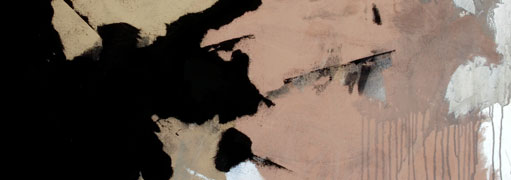When put together, minimalism and abstraction are like the fiery words of a televangelist. The result may be a vessel toward a greater truth, but it may also be a cover-up for a lack of idea and purpose.Bryce Hample’s collection of six 50-by-50-inch paintings at Winning Coffee is certainly a study in abstract minimalism. He employs vast plateaus of muted tones shifting across large canvas and plywood backdrops. Of the six pieces, the majority are large fields of black, gray, white and ochre rust, some with subtle tone gradations. The paint might have been slathered on with a palette knife in a freeform fury. Three of the pieces are marked with splintery holes. One looks like it was riddled with bullets, another like it was beat and stomped upon by an angry dwarf.Looking at Hample’s work, I got to thinking about old Mark Rothko. Not that Rothko was known for ripping apart his canvases, but he did a lot with a little, or a little with a lot, depending on the critic. There are those who would contend Rothko’s color balance in his more popular works have a synesthetic quality—that the visual construction opens up neurological pathways to auditory sensations; the eye becomes the ear. Personally, I’ve never heard a painting sing. But there’s no denying that certain psychological tricks are hidden in Rothko’s work. His use of contrasting colors often creates an optical illusion if you stare long enough. Certain colors will begin to vibrate against others, actually move—like a hallucination. (Think of those Magic Eye books from back in the day.)On the other hand, it can be argued that Rothko’s paintings are big blocks of color devoid of narrative, thought or meaning. It can also be argued that the large-scale format of his pieces is only a sensationalist veil to distract the viewer from the truth that nothing of consequence lies beneath.While Hample isn’t much of a colorist, he’s got a lot of Rothko going on. Let’s start with the title of his series, Paintings . That title could not be more minimalist, or less informative. Then there’s the size of his pieces. They’re huge, with just six of them filling out the largest room at Winning. They demand attention. And like many of Rothko’s pieces, they are not traditionally titled. Just identified by numbers.But most importantly, what’s going on in Hample’s work? There is no apparent narrative. And nothing to suggest there is any figurative meaning behind the subtle, splotched tones that populate his collection.I sat and stared at Hample’s work for an hour, moving from table to table in the coffee shop, examining each painting, attempting to find some connecting signifier that would lead me to a discovery—whether psychological or literal. The more I looked, the more I became engulfed in a Rorschach tunnel. I started thinking about volcanic ash, pigeon shit, a pack of rhinoceros lost in a snowstorm. The paintings were overwhelming, and I couldn’t look away. They began opening strange portals in my imagination.Quite simply, they made me think—very intensely—about things I would not be thinking of had I not been looking at them. That is the most concrete conclusion I can come to about Hample’s work. The whole series kind of reminded me of that Bob Dylan refrain, "Something is happening here, but you don’t know what it is." It’s an inconclusive but mesmerizing song, and you’re too intrigued not to go along for the ride.Hample’s art is industrially elegant and unassuming. You could live with it. It would blend in perfectly in an upscale ’80s Soho coke den. Like Rothko, his work is the type that will probably come off as meaningless or awe-inspiring. As for myself, I left Winning a little confused, a little elated, too consumed by the dramatic cadence of the preacher to worry about what his words meant.
Paintings by Bryce HampleRuns through Nov. 30Winning Coffee111 Harvard SEwinningcoffeeco.com













